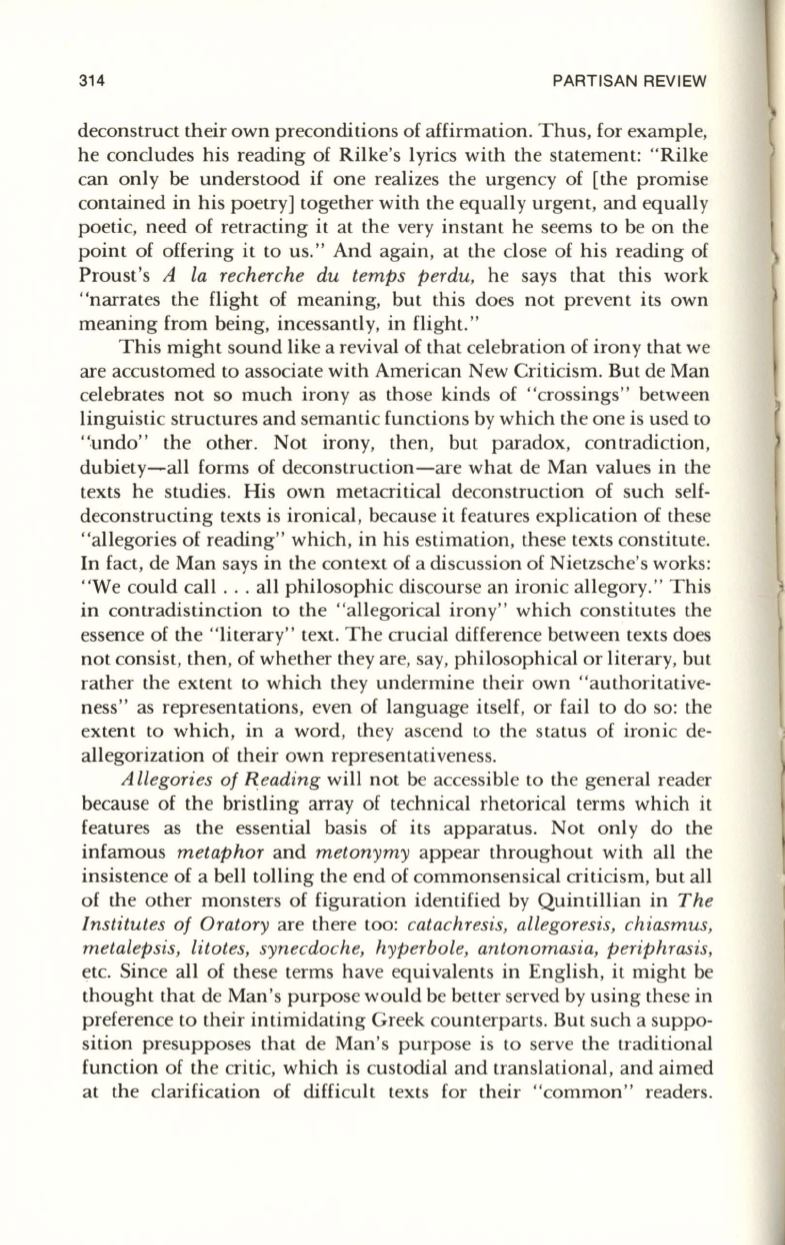
314
PARTISAN REVIEW
deconstruct their own preconditions of affirmation. Thus, for example,
he concludes his reading of Rilke's lyrics with the statement: "Rilke
can only be understood if one realizes the urgency of [the promise
contained in his poetry] together with the equally urgent, and equally
poetic, need of retracting it at the very instant he seems to be on the
point of offering it to us." And again, at the close of his reading of
Proust's
A La recherche du temps perdu,
he says that this work
"narrates the flight of meaning, but this does not prevent its own
meaning from being, incessantly, in flight."
This might sound like a revival of that celebration of irony that we
are accustomed to associate with American New Criticism. But de Man
celebrates not so much irony as those kinds of "crossings" between
linguistic structures and semantic functions by which the one is used to
"undo" the other. Not irony, then, but paradox, contradiction,
dubiety-all forms of deconstruction-are what de Man values in the
texts he studies. His own metacritical deconstruction of such self–
deconstructing texts is ironical, because it features explication of these
"allegories of reading" which, in his estimation, these texts constitute.
In
fact, de Man says in the context of a discussion of Nietzsche's works:
"We could call ... all philosophic discourse an ironic allegory." This
in contradistinction to the "allegorical irony" which constitutes the
essence of the "literary" text. The crucial difference between texts does
not consist, then, of whether they are, say, philosophical or literary, but
rather the extent to which they undermine their own "authoritative–
ness" as representations, even of language itself, or fail to do so: the
extent to which, in a word, they ascend to the status of ironic de–
allegorization of their own representativeness.
Allegories of Reading
will not be accessible to the general reader
because of the bristling array of technical rhetorical terms which it
features as the essential basis of its apparatus. Not only do the
infamous
metaphor
and
metonymy
appear throughout with all the
insistence of a bell tolling the end of commonsensical criticism, but all
of the other monsters of figuration identified by Quintillian in
The
Institutes of Oratory
are there too:
catachresis, allegoresis, chiasmus,
metalepsis, Litotes, synecdoche, hyperbole, antonomasia, periphrasis,
etc. Since all of these terms have equivalents in English, it might be
thought that de Man's purpose would be better served by using these in
preference to their intimidating Greek counterparts. But such a suppo–
sition presupposes that de Man's purpose is to serve the traditional
function of the critic, which is custodial and translational, and aimed
at the clarification of difficult texts for their "common" readers.


